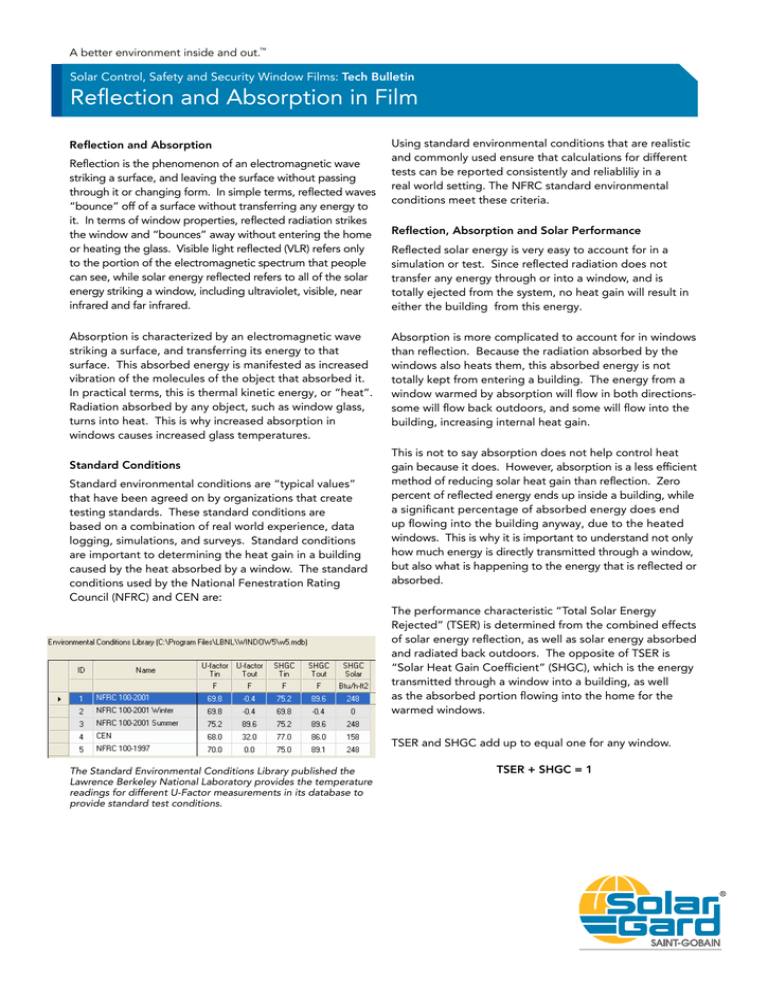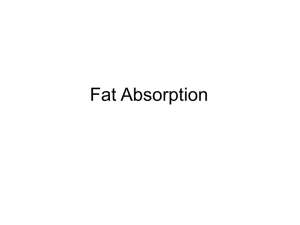
A better environment inside and out.™
Solar Control, Safety and Security Window Films: Tech Bulletin
Reflection and Absorption in Film
Reflection and Absorption
Reflection is the phenomenon of an electromagnetic wave
striking a surface, and leaving the surface without passing
through it or changing form. In simple terms, reflected waves
“bounce” off of a surface without transferring any energy to
it. In terms of window properties, reflected radiation strikes
the window and “bounces” away without entering the home
or heating the glass. Visible light reflected (VLR) refers only
to the portion of the electromagnetic spectrum that people
can see, while solar energy reflected refers to all of the solar
energy striking a window, including ultraviolet, visible, near
infrared and far infrared.
Absorption is characterized by an electromagnetic wave
striking a surface, and transferring its energy to that
surface. This absorbed energy is manifested as increased
vibration of the molecules of the object that absorbed it.
In practical terms, this is thermal kinetic energy, or “heat”.
Radiation absorbed by any object, such as window glass,
turns into heat. This is why increased absorption in
windows causes increased glass temperatures.
Standard Conditions
Standard environmental conditions are “typical values”
that have been agreed on by organizations that create
testing standards. These standard conditions are
based on a combination of real world experience, data
logging, simulations, and surveys. Standard conditions
are important to determining the heat gain in a building
caused by the heat absorbed by a window. The standard
conditions used by the National Fenestration Rating
Council (NFRC) and CEN are:
Using standard environmental conditions that are realistic
and commonly used ensure that calculations for different
tests can be reported consistently and reliabliliy in a
real world setting. The NFRC standard environmental
conditions meet these criteria.
Reflection, Absorption and Solar Performance
Reflected solar energy is very easy to account for in a
simulation or test. Since reflected radiation does not
transfer any energy through or into a window, and is
totally ejected from the system, no heat gain will result in
either the building from this energy.
Absorption is more complicated to account for in windows
than reflection. Because the radiation absorbed by the
windows also heats them, this absorbed energy is not
totally kept from entering a building. The energy from a
window warmed by absorption will flow in both directionssome will flow back outdoors, and some will flow into the
building, increasing internal heat gain.
This is not to say absorption does not help control heat
gain because it does. However, absorption is a less efficient
method of reducing solar heat gain than reflection. Zero
percent of reflected energy ends up inside a building, while
a significant percentage of absorbed energy does end
up flowing into the building anyway, due to the heated
windows. This is why it is important to understand not only
how much energy is directly transmitted through a window,
but also what is happening to the energy that is reflected or
absorbed.
The performance characteristic “Total Solar Energy
Rejected” (TSER) is determined from the combined effects
of solar energy reflection, as well as solar energy absorbed
and radiated back outdoors. The opposite of TSER is
“Solar Heat Gain Coefficient” (SHGC), which is the energy
transmitted through a window into a building, as well
as the absorbed portion flowing into the home for the
warmed windows.
TSER and SHGC add up to equal one for any window.
The Standard Environmental Conditions Library published the
Lawrence Berkeley National Laboratory provides the temperature
readings for different U-Factor measurements in its database to
provide standard test conditions.
TSER + SHGC = 1
The NFRC standard conditions are used to determine
how much absorbed radiation flows into a building when
determining SHGC and TSER. The key factors used are
absorbed radiation, exterior temperatures, and interior
temperatures. In thermal physics, the difference in
temperature between materials is proportional to how
much energy flow there will be between them. The larger
the temperature difference, the more energy flows from
the warmer object to the cooler object.
It is for these reasons the U.S. Government chartered
NFRC, which only recognizes TSER and SHGC as correct
thermal performance methods. Some specifications, such
as those that deal with “IR”, are misleading in that they do
not account for all the solar energy. As a result, TSER and
SHGC are the only specifications that customers should
consider if they seek to understand how much thermal
energy will be kept from entering their buildings. The
calculations for these values take into full account both the
reflected and absorbed radiation.
One final consideration when discussing reflection and
absorption is that highly absorbing films are the “glass
breakers” of the solar control film industry. Though many
factors contribute to glass breakage, such as glass type,
shading, and altitude, films that operate by absorption
rather than reflection are at highest risk of breaking
glass due to thermal stress caused by temperature
increases. This is especially true if total energy absorbed
is approximately 45% or above.
SHGC
SHGC
Re
Re
-R
Absorption
-R
ad
ia
tio
n
(o
ut
)
Re-Radiation (in)
Transmission
Absorption
ad
ia
tio
n
(o
ut
)
Re-Radiation (in)
Transmission
Reflection
Reflection
The window on the left is more absorbing than the window on the right. The heat gain into the home
from the left window is greater than the right, because the left window has higher absorption.
www.solargard.co.uk
Saint-Gobain Performance Plastics
Unit 13, Ball Mill Top Business Park
Grimley, Worcestershire WR2 6LS
United Kingdom
Tel: +44 (0) 1905 640 400
solargarduk@saint-gobain.com
PDF0250SG18RAINT 03/12
© Copyright 2012, Saint-Gobain Performance Plastics Corporation and/or its affiliates
All Rights Reserved • www.solargard.com
Please recycle


